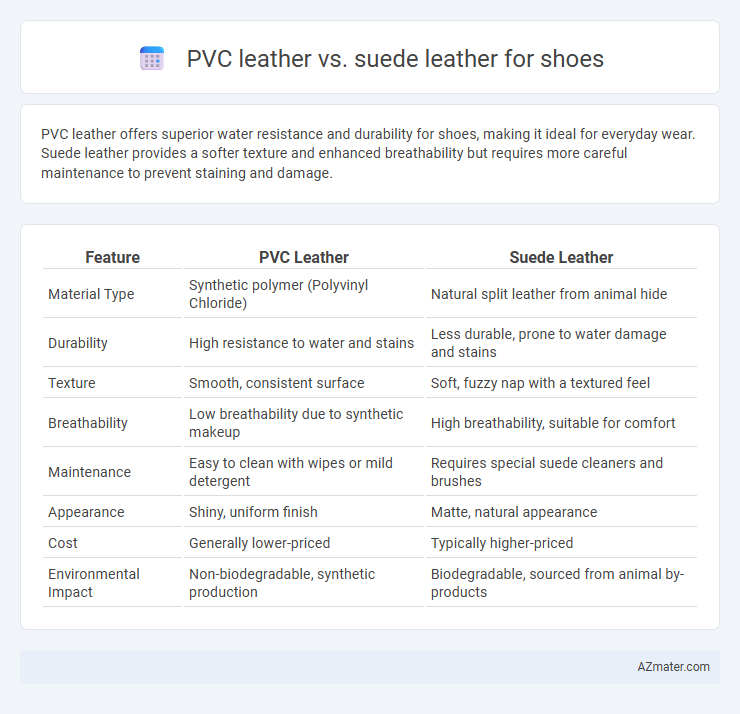PVC leather offers superior water resistance and durability for shoes, making it ideal for everyday wear. Suede leather provides a softer texture and enhanced breathability but requires more careful maintenance to prevent staining and damage.
Table of Comparison
| Feature | PVC Leather | Suede Leather |
|---|---|---|
| Material Type | Synthetic polymer (Polyvinyl Chloride) | Natural split leather from animal hide |
| Durability | High resistance to water and stains | Less durable, prone to water damage and stains |
| Texture | Smooth, consistent surface | Soft, fuzzy nap with a textured feel |
| Breathability | Low breathability due to synthetic makeup | High breathability, suitable for comfort |
| Maintenance | Easy to clean with wipes or mild detergent | Requires special suede cleaners and brushes |
| Appearance | Shiny, uniform finish | Matte, natural appearance |
| Cost | Generally lower-priced | Typically higher-priced |
| Environmental Impact | Non-biodegradable, synthetic production | Biodegradable, sourced from animal by-products |
Introduction to PVC Leather and Suede Leather
PVC leather, a synthetic material crafted from polyvinyl chloride, offers durability, water resistance, and affordability, making it a popular choice in shoe manufacturing. Suede leather, derived from the underside of animal hide, delivers a soft texture, breathability, and natural appearance but requires more delicate care compared to PVC leather. Both materials present distinct advantages for shoes, with PVC excelling in maintenance and durability while suede is favored for its aesthetic and comfort.
Material Composition and Manufacturing Process
PVC leather consists of a synthetic polymer coating on a fabric base, producing a durable, water-resistant material through a chemical plasticization process that mimics natural leather's appearance and texture. Suede leather is derived from the underside of animal hides, primarily cowhide or lambskin, and undergoes a specialized buffing or sanding process that creates its characteristic soft, napped finish. The manufacturing of PVC leather involves extruding polyvinyl chloride and applying pigments and plasticizers, whereas suede requires precise tanning and finishing techniques to maintain flexibility and breathability.
Visual Appearance and Texture Comparison
PVC leather exhibits a smooth, uniform surface with a glossy finish that mimics genuine leather's polished look, making it visually consistent and easy to maintain. In contrast, suede leather has a matte, napped surface created by sanding the inner split of the hide, offering a soft, velvety texture that enhances tactile appeal but is more prone to stains and wear. The difference in texture significantly influences footwear aesthetics, with PVC providing a sleek, modern appearance while suede delivers a classic, luxurious feel.
Durability and Longevity of PVC vs Suede Leather
PVC leather offers superior durability and resistance to water, stains, and scratches compared to suede leather, making it ideal for long-lasting shoes in various weather conditions. Suede leather, while softer and more breathable, is prone to wear, staining, and moisture damage, reducing its overall lifespan. Choosing PVC leather for shoes ensures enhanced longevity and easier maintenance, especially for everyday use.
Comfort and Breathability in Footwear
PVC leather offers durability and water resistance but lacks the breathability found in suede leather, which allows for better air circulation and moisture absorption. Suede leather's porous texture enhances comfort by reducing heat buildup and keeping feet dry during extended wear. Shoes made with suede leather are generally preferred for situations requiring improved ventilation and temperature regulation.
Water and Stain Resistance Differences
PVC leather offers superior water resistance compared to suede leather due to its synthetic, non-porous surface that repels moisture and prevents stains effectively. Suede leather, made from the underside of animal hides, is inherently porous and absorbs water easily, making it more susceptible to water damage and staining without proper treatment. Specialized waterproof sprays can enhance suede's resistance, but PVC leather remains the more durable choice for environments prone to moisture and staining.
Maintenance and Cleaning Requirements
PVC leather shoes offer superior resistance to water and stains, making maintenance straightforward with simple wiping using a damp cloth, while suede leather requires delicate care, involving brushing with a suede brush and occasional use of specialized cleaners to prevent damage and preserve texture. PVC leather's non-porous surface resists dirt buildup and is less prone to fading, allowing for low-effort upkeep compared to the absorbent and easily stained nature of suede. Frequent protective treatments like waterproof sprays are essential for suede shoes to maintain their appearance and durability in contrast to the inherently weather-resistant PVC leather.
Environmental Impact and Sustainability
PVC leather for shoes has a significant environmental impact due to its production involving harmful chemicals and non-biodegradable materials that contribute to long-term pollution. Suede leather, derived from animal hides, involves resource-intensive processes including water use, land use, and greenhouse gas emissions, but it is biodegradable and can be more sustainable with responsible sourcing and tanning methods. Choosing suede leather with eco-friendly tanning techniques reduces environmental harm, whereas PVC leather's synthetic nature poses greater sustainability challenges in waste management and chemical disposal.
Cost and Affordability Analysis
PVC leather offers a more cost-effective option for shoe manufacturing, with prices significantly lower than genuine suede leather due to its synthetic production process. Suede leather, derived from the underside of animal hides, commands higher prices owing to its natural material quality and labor-intensive crafting. For budget-conscious consumers, PVC leather provides affordable durability, while suede appeals to those prioritizing premium aesthetics and texture despite the increased expense.
Best Use Cases: Choosing the Right Leather for Shoes
PVC leather offers superior water resistance and durability, making it ideal for casual and work shoes exposed to wet conditions or rough terrain. Suede leather provides a soft, breathable texture suited for dress shoes and fashion footwear where comfort and aesthetic appeal are prioritized. Selecting between PVC and suede leather depends on the shoe's intended environment and style requirements, with PVC favored for practicality and suede for elegance.

Infographic: PVC leather vs Suede leather for Shoe
 azmater.com
azmater.com